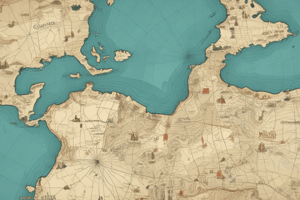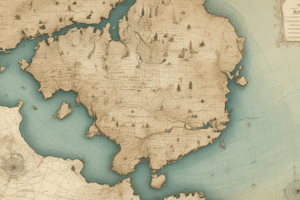Podcast
Questions and Answers
What is the purpose of dividing a toposheet into a grid system?
What is the purpose of dividing a toposheet into a grid system?
- To measure the distance between two points
- To facilitate location and measurement of distances (correct)
- To represent the scale of the map
- To draw contour lines
What is the ratio of the distance on the map to the corresponding distance on the ground?
What is the ratio of the distance on the map to the corresponding distance on the ground?
- Scale (correct)
- Grid interval
- Elevation
- Contour line
Which grid system is used in the United States?
Which grid system is used in the United States?
- State Plane Coordinate System (correct)
- Universal Polar Stereographic (UPS) system
- Cartesian Coordinate System
- Universal Transverse Mercator (UTM) system
What do closely spaced contour lines indicate?
What do closely spaced contour lines indicate?
What is the purpose of contour lines on a toposheet?
What is the purpose of contour lines on a toposheet?
What is the characteristic of a contour line that forms a 'V' shape?
What is the characteristic of a contour line that forms a 'V' shape?
Flashcards are hidden until you start studying
Study Notes
Grid Systems
- A toposheet is divided into a grid system to facilitate location and measurement of distances
- Grid lines are spaced at regular intervals, usually 1 km or 1 mile apart
- Grid systems used in toposheets include:
- Universal Transverse Mercator (UTM) system
- Universal Polar Stereographic (UPS) system
- State Plane Coordinate System (used in the United States)
Scale Representation
- Toposheets are drawn to a specific scale, which is the ratio of the distance on the map to the corresponding distance on the ground
- Scale is represented as a fraction (e.g. 1:25,000) or as a verbal statement (e.g. 1 inch = 1 mile)
- Toposheets can have different scales, such as:
- Large-scale maps (e.g. 1:10,000) for detailed planning and navigation
- Small-scale maps (e.g. 1:100,000) for general overview and planning
Contour Lines
- Contour lines are used to represent the relief of the terrain on a toposheet
- A contour line is an imaginary line on the map that connects points of equal elevation
- Contour lines have the following characteristics:
- Closely spaced lines indicate steep slopes
- Widely spaced lines indicate gentle slopes
- Contour lines that form a "V" shape indicate a valley or depression
- Contour lines that form a "U" shape indicate a ridge or hill
Grid Systems
- Grid systems are used in toposheets to facilitate location and measurement of distances
- Grid lines are spaced at regular intervals, usually 1 km or 1 mile apart
- Three common grid systems used in toposheets are: • Universal Transverse Mercator (UTM) system • Universal Polar Stereographic (UPS) system • State Plane Coordinate System (used in the United States)
Scale Representation
- Toposheets are drawn to a specific scale, which is the ratio of the distance on the map to the corresponding distance on the ground
- Scale can be represented as a fraction (e.g. 1:25,000) or as a verbal statement (e.g. 1 inch = 1 mile)
- Two types of scales used in toposheets are: • Large-scale maps (e.g. 1:10,000) for detailed planning and navigation • Small-scale maps (e.g. 1:100,000) for general overview and planning
Contour Lines
- Contour lines are used to represent the relief of the terrain on a toposheet
- A contour line connects points of equal elevation on the map
- Characteristics of contour lines: • Closely spaced lines indicate steep slopes • Widely spaced lines indicate gentle slopes • Contour lines that form a "V" shape indicate a valley or depression • Contour lines that form a "U" shape indicate a ridge or hill
Studying That Suits You
Use AI to generate personalized quizzes and flashcards to suit your learning preferences.




